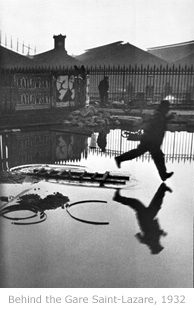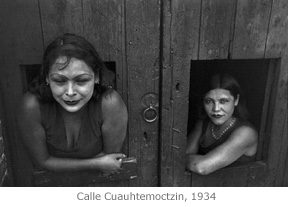|
||
| Biography:
Cartier-Bresson is well known for his concept of the “decisive moment” in photography. He defined this moment as “the simultaneous recognition, in a fraction of a second, of the significance of an event as well as of a precise organization of forms which gave that event its proper expression." His famous photograph of a man jumping over a puddle ("Behind the Gare Saint-Lazare, 1932") illustrates this concept perfectly. During his photographic career Cartier-Bresson photographed all over the world - Mexico, Canada, USA, Europe, India, Burma, Pakistan, Indonesia, Africa, Burma, China, Japan, Cuba, and the USSR, among other places. He also photographed many famous personalities and artists of the 20th century, including Matisse, Picasso, Coco Chanel, Truman Capote, and Gandhi. His interest in the visual arts also extended to film - he made films with Jean Renoir, Jacques Becker and André Zvoboda and a documentary on Republican Spain (1937). During the Second World War Cartier-Bresson was taken prisoner by the Germans and escaped, then photographed the occupation and liberation of France. During this time rumors reached the USA that he had been killed, and the Museum of Modern Art began to prepare a “posthumous” show. Cartier-Bresson later spent a year in the US helping to prepare this show. In
1947 Cartier-Bresson co-founded the photographic cooperative Magnum
along with fellow photographers Robert Capa, George Rodger, David Seymour,
Bill Vandivert and others. Cartier-Bresson retired from photography in the early 1970s to return to drawing and painting. Although no longer taking photos, his influence on photographers and the photographic world was solidified. The Henri Cartier-Bresson Foundation was created by Cartier-Bresson and his wife and daughter in 2002 to preserve and share his legacy. Henri Cartier-Bresson died on August 3rd, 2004 in Paris. He is survived by his wife and fellow photographer Martine Franck, and his daughter Melanie. |
||
|
||
| Publications
by Henri Cartier-Bresson Henri
Cartier-Bresson in India text
by Yves Véquaud Line
by Line, Henri Cartier-Bresson's Drawings
America in Passing A
propos de Paris
Mexican Notebooks 1934-1964 Henri
Cartier-Bresson and the Artless Art
Europeans Tête
à tête Landscape
Townscape
|
||
| Links
to Cartier-Bresson's work: Henri Cartier-Bresson Foundation Howard Greenberg Gallery Magnum Photos National Portrait Gallery Galerie Esther Woerdehoff |
|
© copyright 2004 Women In Photography International DISCLAIMER: The WIPI web site presents a wide variety of artistic photographic styles and personalities. Images and/or text content may be perceived differently in various countries or by various age groups. It is the responsibility of the artist, photographer, writer, or company to provide Women In Photography International with copyrighted material. The "contributor" shall hold Women In Photography International harmless from and against any loss, expense, or damage occasioned by any claim, demand, suit or recovery against the "contributor" arising out of the use of the images for the Women In Photography International online web site. |





